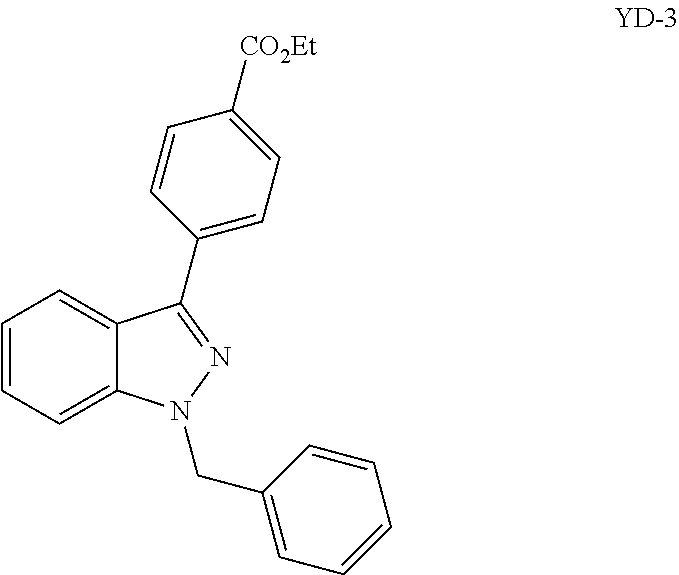Substituted 5-Membered Heterocyclic Analogs as Protease Activated Receptor 4 (PAR-4) Antagonists
- Summary
- Abstract
- Description
- Claims
- Application Information
AI Technical Summary
Benefits of technology
Problems solved by technology
Method used
Image
Examples
examples / experimental
E. Examples / Experimental
[0269]Some of the compounds of the instant invention have at least one asymmetric center. Additional asymmetric centers may be present depending upon the nature of the various substituents on the molecule. Compounds with asymmetric centers give rise to enantiomers (optical isomers), diastereomers (configurational isomers) or both, and it is intended that all of the possible enantiomers and diastereomers in mixtures and as pure or partially purified compounds are included within the scope of this invention. The present invention is meant to encompass all such isomeric forms of these compounds.
[0270]The independent syntheses of the enantiomerically or diastereomerically enriched compounds, or their chromatographic separations, may be achieved as known in the art by appropriate modification of the methodology disclosed herein. Their absolute stereochemistry may be determined by the x-ray crystallography of crystalline products or crystalline intermediates that a...
example 1
B1) Methyl 3-(2-methoxyimidazo[2,1-b][1,3,4]thiadiazol-6-yl)-5-(trifluoromethoxy)-1H-indole-2-carboxylate
[0293]
[0294]Step 1. Ethyl 3-(2-chloroacetyl)-5-(trifluoromethoxy)-1H-indole-2-carboxylate (Intermediate A1) was dissolved in acetone (5.4 mmol) and NaBr (1.08 mmol) was added to the solution and the reaction mixture was stirred at 50° C. for 16 hr. Upon completion, the reaction was filtered, concentrated under reduced pressure and used directly in the next reaction. A mixture of ethyl 3-(2-bromoacetyl)-5-(trifluoromethoxy)-1H-indole-2-carboxylate (0.45 mmol) and 5-bromo-1,3,4-thiadiazol-2-amine (0.68 mmol) were dissolved in CH3CN / IPA (1:1; 5.6 mL) in a microwave vial that was sealed and heated to 80° C. for 18 hr. Next, the vial was placed in a Microwave for 30 minutes at 150° C. The reaction was diluted with DCM, washed with saturated NaHCO3 (10 mL), brine, and dried over magnesium sulfate. Purification by silica chromatography (Hexanes-30% EtOAc / Hexanes-80% EtOAc / Hexanes) affor...
example 2
e 1) 2-Methoxy-6-(5-phenylthiophen-2-yl)imidazo[2,1-b][1,3,4]thiadiazole
[0296]
[0297]Step 1. A mixture of commercially available 2-bromo-1-(5-phenylthiophen-2-yl)ethan-1-one (0.10 mmol) and 5-bromo-1,3,4-thiadiazol-2-amine (0.15 mmol) were dissolved in CH3CN / IPA (1:1; 1.3 mL) in a microwave vial that was sealed and heated to 80° C. for 18 hr. Next, the vial was placed in a Microwave for 30 minutes at 150° C. The reaction was diluted with DCM, washed with saturated NaHCO3 (10 mL), brine, and the organic layer was passed through a phase separator. The organic layer was concentrated under reduced pressure and the crude product was used directly in the next step without purification.
[0298]Step 2. A solution of 2-bromo-6-(5-phenylthiophen-2-yl)imidazo[2,1-b][1,3,4]thiadiazole (0.10 mmol) in a mixture of DCM / MeOH (4:1; 5 mL) was treated at 22° C. with a 25 wt. % solution of NaOMe (0.40 mmol) in MeOH. Next, an additional 1 mL of MeOH was added and the reaction was stirred for 1 hr. Upon com...
PUM
 Login to View More
Login to View More Abstract
Description
Claims
Application Information
 Login to View More
Login to View More - R&D
- Intellectual Property
- Life Sciences
- Materials
- Tech Scout
- Unparalleled Data Quality
- Higher Quality Content
- 60% Fewer Hallucinations
Browse by: Latest US Patents, China's latest patents, Technical Efficacy Thesaurus, Application Domain, Technology Topic, Popular Technical Reports.
© 2025 PatSnap. All rights reserved.Legal|Privacy policy|Modern Slavery Act Transparency Statement|Sitemap|About US| Contact US: help@patsnap.com



